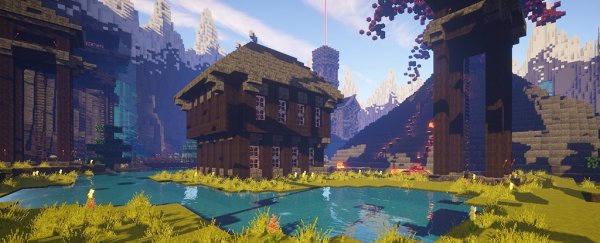Microsoft had big plans when it purchased Minecraft, the immensely popular open-world 'sandbox' game, back in 2014 for US$2.5 billion. Among them was to invest heavily in an educational revolution – the gamification of learning.
It's not hard to imagine how the logic-based mechanics of Minecraft's construction system could help teach knowledge and practical skills in fields of science, technology, engineering, and mathematics (STEM).
But whether there's room to cover more nuanced, theoretical matters in other disciplines, such as history or humanities, remains something of an open question.
English professor Darren Wershler and sociologist Bart Simon from Concordia's Milieux Institute for Arts, Culture, and Technology have put forward the argument that if it's taught the right way, Minecraft has a place in just about any kind of classroom.
Described as an 'allegorical build', the pair's teaching method is underpinned by principles of engaging with the failures inherent in the gameplay and its programming, and reflection on how to relate what is already known about the real world to Minecraft's in-game universe.
It means treating the challenges within the game's survival aspects and its unique mix of risks and dilemmas not as obstacles students need to overcome in order to learn, but as features that intrinsically communicate concepts about our own history and culture.
The pair based their method on a class taught by Wershler on the rise of the modern world. Part of that course relied heavily on using Minecraft as a resource.
In this course, large mining and processing machines were added to the game, along with the ability to produce steel and something resembling a power grid. By doing so, the game can illustrate concepts related to industrialization's impacts on the environment.
"The course is not a video game studies course, and it is not a gamified version of a course on modernity," says Wershler.
"It's this other thing that sits in an uncomfortable middle and brushes up against both. The learning comes out of trying to think about those two things simultaneously."
Over the past decade, Minecraft has evolved from a rather simple survival game of resource management into a complex digital realm where just about anything can be constructed (including virtual computers that in turn can run their own pared-down version of Minecraft).
In that time, its trademark blocky graphics have remained relatively unchanged, as both a recognizable part of its brand and as a core feature of the Minecraft experience.
This very mix of economic interface, flexibility, and complexity makes the program capable of teaching a variety of skills in an engaging way, so much so that Microsoft developed an educational version of the program targeting teachers and students.
The pros to learning this way are obvious, especially as classrooms increasingly flip the learning process to make better use of non-contact time, a practice that became vital during lockdowns.
Whether it's for the incentives and challenges that come with games or simply as an interactive model, using games to teach fundamental concepts is by no means nothing new.
Even in digital terms, computer games have appeared in lessons for as long as computers have been in the classroom.
That being said, games' ability to solve problems in engagement and self-direction remains hotly debated. Gamification of teaching resources is both overhyped and underappreciated, depending on who you ask.
One thing is for certain, though: Online educational resources, whether in the form of games or more traditional text and video, have a renewed importance in our post- pandemic educational landscape.
Perhaps the most important lesson in Wershler's and Simon's work is to ignore the fact programs like Minecraft are games and instead regard them like any other teaching resource – one among a set of tools a skilled teacher can use to achieve a learning objective for any lesson.
"It was important that the game remained a game and that while the students were working on their projects, there were all these horrible things coming out of the wilderness to kill them," says Wershler.
"This makes them think about the fact that what they are doing requires effort and that the possibility of failure is very real."
This research was published in gamenvironments.
